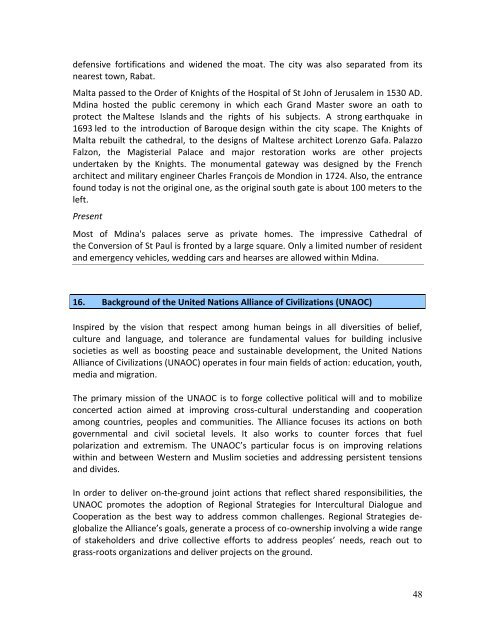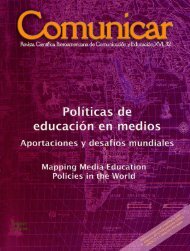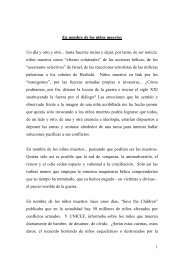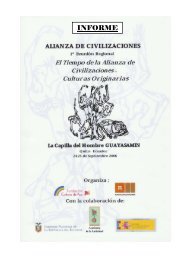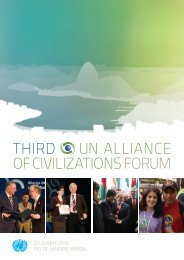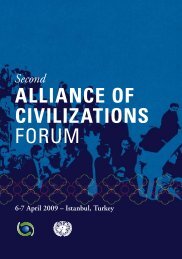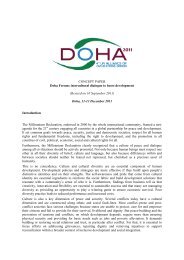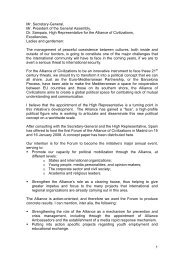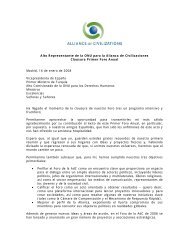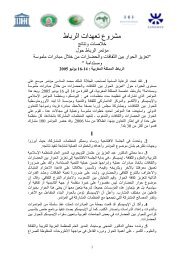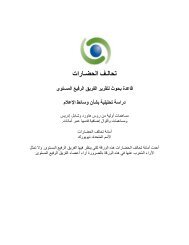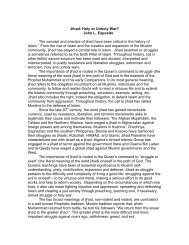detailed information about the 4th UNAOC Summer School
detailed information about the 4th UNAOC Summer School
detailed information about the 4th UNAOC Summer School
You also want an ePaper? Increase the reach of your titles
YUMPU automatically turns print PDFs into web optimized ePapers that Google loves.
defensive fortifications and widened <strong>the</strong> moat. The city was also separated from its<br />
nearest town, Rabat.<br />
Malta passed to <strong>the</strong> Order of Knights of <strong>the</strong> Hospital of St John of Jerusalem in 1530 AD.<br />
Mdina hosted <strong>the</strong> public ceremony in which each Grand Master swore an oath to<br />
protect <strong>the</strong> Maltese Islands and <strong>the</strong> rights of his subjects. A strong earthquake in<br />
1693 led to <strong>the</strong> introduction of Baroque design within <strong>the</strong> city scape. The Knights of<br />
Malta rebuilt <strong>the</strong> ca<strong>the</strong>dral, to <strong>the</strong> designs of Maltese architect Lorenzo Gafa. Palazzo<br />
Falzon, <strong>the</strong> Magisterial Palace and major restoration works are o<strong>the</strong>r projects<br />
undertaken by <strong>the</strong> Knights. The monumental gateway was designed by <strong>the</strong> French<br />
architect and military engineer Charles François de Mondion in 1724. Also, <strong>the</strong> entrance<br />
found today is not <strong>the</strong> original one, as <strong>the</strong> original south gate is <strong>about</strong> 100 meters to <strong>the</strong><br />
left.<br />
Present<br />
Most of Mdina's palaces serve as private homes. The impressive Ca<strong>the</strong>dral of<br />
<strong>the</strong> Conversion of St Paul is fronted by a large square. Only a limited number of resident<br />
and emergency vehicles, wedding cars and hearses are allowed within Mdina.<br />
16. Background of <strong>the</strong> United Nations Alliance of Civilizations (<strong>UNAOC</strong>)<br />
Inspired by <strong>the</strong> vision that respect among human beings in all diversities of belief,<br />
culture and language, and tolerance are fundamental values for building inclusive<br />
societies as well as boosting peace and sustainable development, <strong>the</strong> United Nations<br />
Alliance of Civilizations (<strong>UNAOC</strong>) operates in four main fields of action: education, youth,<br />
media and migration.<br />
The primary mission of <strong>the</strong> <strong>UNAOC</strong> is to forge collective political will and to mobilize<br />
concerted action aimed at improving cross-cultural understanding and cooperation<br />
among countries, peoples and communities. The Alliance focuses its actions on both<br />
governmental and civil societal levels. It also works to counter forces that fuel<br />
polarization and extremism. The <strong>UNAOC</strong>’s particular focus is on improving relations<br />
within and between Western and Muslim societies and addressing persistent tensions<br />
and divides.<br />
In order to deliver on-<strong>the</strong>-ground joint actions that reflect shared responsibilities, <strong>the</strong><br />
<strong>UNAOC</strong> promotes <strong>the</strong> adoption of Regional Strategies for Intercultural Dialogue and<br />
Cooperation as <strong>the</strong> best way to address common challenges. Regional Strategies deglobalize<br />
<strong>the</strong> Alliance’s goals, generate a process of co-ownership involving a wide range<br />
of stakeholders and drive collective efforts to address peoples’ needs, reach out to<br />
grass-roots organizations and deliver projects on <strong>the</strong> ground.<br />
48


